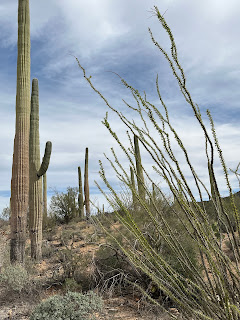We spent 9 days at Picacho Peak State Park, located approximately 25 miles west of Tuscon. The campground sits at the base of Picacho Peak which rises a stately 1,500’. The camp has just shy of 100 campsites - but because it is on a gentle slope it never feels like you are too close to other campers. The view down into the valley, the sight and sounds of trains in the distance, and the clear night sky (away from the lights of the city proper) make it an ideal spot. The campground has many hiking trails - some very challenging and others more scenic in nature. We tend to choose the scenic routes.
Since arriving in Arizona our weather has been glorious! Daytime temps in the low 70’s with nighttime dips into the high 40’s. Perfect.
Having an extended amount of time in one place has allowed us to fall into a rhythm - a day of outdoor or museum activities followed by a day of relaxing campside! No stress….. isn’t that what retirement is supposed to be?
When heading into Tuscon (or any larger town we are visiting) we try to combine that daily activity with fulfilling other normal life needs such as getting laundry done, doing groceries and, of course, searching out new breweries! Luck has it - we always find a good brewery.
It’s peak, covered in snow this time of year, Mount Lemmon, at 9,159’, is the highest point in the Santa Catalina Mountains. These mountains are part of the Coronado National Forest and are the southern most tip of the Rocky Mountain Range. The Catalina Highway , which begins on the northern outskirts of Tuscon, and climbs 6,000’ to Summerhaven, a ski resort near the top of Mount Lemmon, is one of the most scenic highways in the Southwest! The 27 miles of twists and turns begins with the low Sonoran topography of desert and climbs to the cool mountain forests of an Alpine zone. At every curve it seemed that we saw some new environment; at first saguaros and prickly pear filled the landscape, then stark rock formations and hoodoos, followed by towering pine and aspen, and then SNOW! All in 27 miles! Crazy.
The following day Summerhaven got an additional 5” of snow.
*
Saguaro are the largest cacti in the U.S. They grow very slowly at first…. maybe an inch a year during their first 8 years! It often takes up to 70 years for them to sprout branches (arms) and will reach full height between 40’-50’ when they are around 150 years old!! The Sonoran Desert creates a perfect habitat for saguaros - and the park is so densely filled that it is truly a forest of saguaros. It was stunning… arid, majestic, and, again, otherworldly.
In the park there are many trails to explore for all abilities and one dirt loop road.
*
Arizona-Sonora Desert Museum is a 21 acre botanical garden and zoo with over 2 miles of walking paths. Stunning gardens that showcase the ecosystem of the Sonoran Desert! A must see if you are ever in this region.
Just can’t get enough of sooooo many beautiful cactus!! And their flowers!
*
Leaving Tuscon we headed southwest on state route 15 thru the Tohono O’Odham Indian Reservation (People of the Desert). The Santa Rosa Valley, stretched out and quite barren, is sprinkled with very small communities (consisting of maybe a dozen homes or less…). Some of these communities have been abandoned and only the decaying houses are left.
Small roadside shrines (capillitas) seemed to line our route through the reservation. I must have counted at least 40 of them before I stopped counting. Some were quite elaborate and looked like mini cathedrals and others were quite simple. I did not want to stop and take pictures because I felt it would be intrusive. Also scattered along this road were small community graveyards - white wooden crosses festooned with plastic flowers and wreaths. I read that many of these graveyards, like the community they were part of, are abandoned. However, each year on the days of Dia De Los Muertos, family members still return to clean and decorate the graves.
*
Organ Pipe Cactus National Monument is located in southern Arizona and shares a border with the Mexican state of Sonora. Although common in Mexico, the park is the only place in the U.S where organ pipe cactus grow wild. 28 different cactus species live here in what are, for most of the year, extreme weather conditions. During the spring and summer temps can easily exceed 110 degrees with the ground temp often hitting 175! Currently it is quite windy with daytime temps around 58 degrees and nighttime lows around 38.
We will stay here for 4 days and then head into SoCal.


















No comments:
Post a Comment